Highlights
- The combinations of the alloying elements Ni, Co and Mo narrow the crystallization interval.
- The temperatures of the beginning and end of the crystallization process of the alloys were recorded.
- During the phase analysis, no intermetallics with the participation of Cr and Mo were registered.
- With increasing cobalt content, the intermetallic Al7CoCu2 was recorded.
Abstract
To increase the mechanical and improve the operational properties of the AlSi25Cu4Cr and AlSi25Cu5Cr alloys, combinations of the alloying elements Ni, Co and Mo were used. The AlSi25Cu4Cr alloy was additionally alloyed with both Ni and Mo and Ni, Co and Mo, and the AlSi25Cu5Cr alloy was alloyed with Co and Mo in different concentrations. The dental alloys “wiron light” and “wironit” were used to introduce the elements Ni, Co, Mo, as well as additional amounts of Cr into the composition of the base compositions. The thermal analysis recorded a decrease in the liquidus and solidus temperatures of the base alloys, as well as a narrowing of their crystallization temperature range as a result of the added alloying elements. The influence of the used chemical elements on the phase composition of the alloys was established by X-ray diffraction. The elements Cr and Mo do not form secondary strengthening phases but dissolve in the α-solid solution. The results of the corrosion tests conducted in 1 M HCl solution and 1 M H2SO4 solution for 336 h and 504 h show that the elements Ni, Co and Mo improve the corrosion resistance of the alloys.
1. Introduction
Aluminum alloys have found wide application in mechanical engineering due to their good combination of mechanical, physical and operational properties. These properties directly depend on the microstructure of the alloys, which in turn depends on the alloying elements and modifiers used. Alloys from the aluminum–silicon system belong to the foundry aluminum alloys. Hypoeutectic and eutectic compositions are characterized by good technological, mechanical and operational properties, while hypereutectic alloys from the system have poorer technological properties but have a lower coefficient of thermal expansion upon heating and better wear resistance compared to other alloys from the system [,]. This is the reason why hypereutectic alloys are mainly used for the production of parts operating at elevated temperatures in friction pairs such as pistons for internal combustion engines [,].
The influence of some of the alloying elements used to influence the properties of aluminum alloys is presented in [,]. The main alloying elements used in the production of piston aluminum–silicon alloys are Si, Mg, Cu and Ni because they have a positive influence on the properties of the alloys after heat treatment [,]. The use of Mg in alloys alloyed with silicon leads to the formation of the Mg2Si hardening phase and its participation in other intermetallics after T6 thermal treatment, which in turn increases the strength indicators of the alloys but decreases the plastic ones [,,,].The addition of Cu to aluminum alloys leads to an increase in their mechanical properties [,,,,] due to the fact that, after heat treatment, the CuAl2 phase is formed and separated. The addition of nickel (Ni) to aluminum alloys leads to an increase in mechanical strength, wear resistance and even plasticity due to the strengthening of the solid solution after heat treatment [,,]; it also has a positive effect on the corrosion resistance of the alloys []. When the nickel content in the composition of the alloys increases (above 1 wt%), agglomeration of Ni-rich intermetallics is observed, which in turn is the cause of a decrease in the strength characteristics of the alloys [].
The presence of iron in the composition of aluminum alloys is undesirable due to the formation of intermetallic phases that deteriorate both the technological and mechanical properties of the alloys. The negative effect and the different morphologies of iron-containing phases are presented in []. To eliminate the harmful effect of Fe-rich phases, the elements manganese (Mn), chromium (Cr), cobalt (Co), beryllium (Be), molybdenum (Mo), nickel (Ni), vanadium (V), tungsten (W), strontium (Sr), as well as the rare earth elements cerium (Ce), lanthanum (La), neodymium (Ne) and yttrium (Y) are added to the alloys [,]. Elements with a high melting point, such as Cr, Mo, V and W, are rarely used in Al-Si alloys due to their limited solubility in aluminum, but, on the other hand, they can be useful for strengthening the alloys after heat treatment. These elements can form intermetallic phases that make the alloy brittle, especially at lower cooling rates during casting. Therefore, their addition is not recommended in alloys for sand or ceramic casting. At higher cooling rates (casting in molds), a saturated α-solid solution is obtained and the mechanical properties of the alloys are improved []. The precise dosage of the amounts of the indicated elements is of utmost importance. As a general rule, a minimum Mn:Fe ratio of 0.5 is recommended, especially when the iron content in the alloy is above 0.45 wt% []. At higher Mn contents, deterioration of mechanical properties may occur due to the formation of a larger amount of intermetallic phases []. As with manganese, higher chromium contents deteriorate the properties of the alloys due to the formation of larger amounts of iron-containing phases [,,]. Chromium is considered more effective when used in a ratio to iron (Cr:Fe) above 0.33 [], and it has a positive effect on the properties of the alloy after heat treatment [,,,,,]. Cobalt is considered less effective than manganese and chromium, but it has a less harmful effect on the alloys. Although less frequently used, there is evidence of the positive modifying effect of molybdenum (Mo) on the AlFeSi phase [].
To modify the eutectic in the composition of alloys, sodium (Na), strontium (Sr) and antimony (Sb) are usually used, which change the eutectic morphology to a finer fibrous structure []. The positive influence of sodium is discussed in [,,], and the positive influence of strontium is discussed in [,,,,]. The combination of Na and Sr leads to an increase in the modifying effect of the alloys []. Modification with antimony is characterized by the formation of lamellar eutectics [,], and its positive effect is presented in [,,].
To modify the α-crystals in the alloy structures, titanium (Ti) and boron (B) introduced into the melts through Al-Ti-B-based ligatures are most often used [].
For modifying free silicon crystals in the structures of hypereutectic compositions, phosphorus (P) has found the most widespread application [,,] but other modifiers, including nanoscale ones, are also being experimented with [,].
The aim of this work is to investigate the influence of the alloying elements Ni, Co, Mo and the combinations thereof on the crystallization process, phase composition and corrosion resistance of the AlSi25Cu4Cr and AlSi25Cu5Cr alloys.
2. Materials and Methods
The object of the present study are the hypereutectic aluminum–silicon alloys AlSi25Cu4Cr and AlSi25Cu5Cr, which are additionally alloyed with the elements Ni, Co, Mo and their combinations. The alloys are melted in an electric resistance furnace under a layer of covering–refining flux (10 KCl:50 NaCl:10 Na3AlF6) in an amount of 0.5 wt% of the mass of the alloys. The AlSi25Cu4Cr alloy is additionally alloyed with both Ni, Cr and Mo, and with the combination of Ni, Cr, Co and Mo. The AlSi25Cu5Cr alloy is alloyed with the combination of the elements Co, Cr and Mo in different concentrations. For alloying the alloys with Ni, Co and Mo, and for introducing additional amounts of Cr into the composition of the base alloys, the dental alloys “wiron light” and “wironit” [,,] were used, and the chemical composition of the two alloys is shown in Table 1 and Table 2.

Table 1.
Chemical composition of “wiron light” alloy [wt%].

Table 2.
Chemical composition of “wironit“ alloy [wt%].
Dental alloys were introduced into the melts of the studied alloys at a temperature of 810 °C. After alloying and mechanical stirring of the melts, they were kept for 30 min at a temperature increased to 850 °C. Metallurgical processing of the alloys was carried out, which included refining, degassing (argon purging) and modification with phosphorus. The compositions based on the AlSi25Cu4Cr alloy were modified with phosphorus in an amount of 0.04 wt% and those based on the AlSi25Cu5Cr alloy with phosphorus 0.07 wt%. Phosphorus was introduced into the melts by using the CuP10 ligature. The metallurgical processing of the melt was carried out at a temperature of 850 °C, and the casting temperature was 830 °C. The thermal analysis of the studied alloys was carried out using the specialized software PicoLog6, with data being recorded every 100 ms and temperature measurements being taken with a thermocouple type K (Ni-CrNi). Casting cores in the form of a cup were used for casting test bodies from both alloys, and the weight of the castings was about 0.6 kg. Experimental castings were cast to produce samples for conducting phase analysis and corrosion studies of the alloys using metal equipment preheated to 200 °C.
To determine the chemical composition of the studied alloys, a spectral analysis of the studied alloys was performed using an Oxford Instruments FOUNDRY-MASTER UV apparatus (Abingdon, UK). The FOUNDRY-MASTER UV is a reliable, precise laboratory spectrometer for the qualitative and quantitative element analysis of metallic samples. The instrument is designed for stationary use as a benchtop unit. The instrument is based on Optical Emission Spectroscopy (OES), the analyzing method favored by most metal-producing and metal-processing companies. The digital source (spark generator) is controlled via the external Windows® PC and offers ideal excitation parameters for the most diverse alloys. The high-resolution Multi-CCD optics utilizes a traditional, robust, vacuum technology chamber rather than eccentric ways of removing harmful atmosphere from the optics. The optics covers the complete wavelength range from 160 nm to 800 nm.
After processing the results of the registered time–temperature curves, and especially the temperature of the solidus lines of the alloys, the operating parameters of the subsequent heat treatment were selected. The castings were heat treated according to the T6 regime, in which the heating for homogenization of the structure was at a temperature of 510–515 °C, the holding time at this temperature was 6 h 30 min, and the cooling medium used for quenching was water with a temperature of 20 °C. Artificial aging after quenching of the test bodies was carried out at a temperature of 180 °C, and the holding time at the selected operating temperature was 12 h.
A heat treatment phase analysis of the studied alloys was performed. The X’Pert PRO MPD diffractometer (Malvern Panalytical B.V., Almelo, The Netherlands) with cobalt radiation was used for obtaining X-ray diffraction (XRD) patterns. Phase analysis was performed in HighScore Plus (Malvern Panalytical B.V., Almelo, The Netherlands) using the PDF2 database. The irradiated volume was defined by the experimental geometry of the diffractometer (Bragg–Brentano), the effective penetration depth of the X-ray radiation (approx. 10 µm), and the pinhole size (1 × 1 mm). Diffraction data were obtained from a surface that had been previously electropolished to minimize the effect of surface preparation and thus to describe the bulk phase composition.
The microstructure of the alloys was studied using a Leica DM ILM microscope (Wetzlar, Germany) with the help of software and a module for grain measurement and phase analysis. The microsections were wet ground on sandpaper with the numbers 240, 320, 400, 600, 800 and 1000 and mechanically polished with diamond paste and lubricant. The microstructure of the samples was developed with Keller’s reagent (1 part HF, 1.5 parts HCl, 2.5 parts HNO3, 95 parts H2O).
After the alloys were subjected to T6 heat treatments, corrosion tests of the compositions were carried out in 1 M HCl solution and 1 M H2SO4 solution for 336 h and 504 h using the gravimetric method, in which the mass loss of the test bodies determines their corrosion rate. The total surface area of each of the samples is 0.02 m2. Before testing, the samples were placed in ethyl alcohol for 10 min, washed with distilled water, dried and weighed on an Acculab ATILON analytical balance. Then, they were immersed in 1 M H2SO4 and HCl solutions at room temperature. The measurements were made after the test bodies had been in the tested environments for 336 and 504 h. After each test period, samples of the tested alloys were cleaned with a brush under running water, dried and weighed, and the test solutions were replaced with new ones. For each of the periods of the sample study, the mass loss and corrosion rate (CR g/m2·h) were calculated and the research methodology is presented in [].
3. Results
After casting the experimental castings, a spectral analysis of the studied alloys was carried out using an Oxford Instruments Foundry Master UV apparatus, and Table 3 shows the designations adopted for the present studies and the chemical composition of the alloys.

Table 3.
Designations and chemical composition of the studied alloys [wt%].
From the recorded time–temperature curves obtained during the thermal analysis, data were taken for the beginning and end of the crystallization process, the degree of supercooling at the eutectic crystallization temperature of both the base alloys AlSi25Cu4Cr and AlSi25Cu5Cr and the additionally alloyed compositions. The liquidus line temperature of the AlSi25Cu4Cr alloy is 776 °C, the solidus line is 569.5 °C and the degree of supercooling at the eutectic crystallization temperature is 1.2 °C (Figure 1a). The AlSi25Cu4Cr alloy additionally alloyed with Ni and Mo (No. 1) has a lower temperature in regard to the liquidus and solidus lines of the alloy (TL—755.8 °C and TS—567 °C), and the degree of supercooling at the solidus line is ∆T—0.7 °C (Figure 1b). In the case of the AlSi25Cu4Cr alloy additionally alloyed with Ni, Co and Mo (No. 2), a decrease in the studied parameters of the crystallization process was again registered (TL—753.8 °C, TS—566.3 °C, ∆T—0.6 °C), as seen in Figure 1c. In the case of alloy No. 3, the tendency to decrease the temperatures at the beginning and end of the crystallization process (TL—753.2 °C, TS—566 °C) is maintained as they are lower than those of the base alloy, and a small degree of supercooling (∆T—0.6 °C) was again registered during the eutectic crystallization of the alloy (Figure 1d). The alloying elements Ni, Co and Mo used in different concentrations narrow the temperature range of crystallization, but this does not lead to a change in the sizes of the primary silicon crystals in the structure of the alloys—they are comparable [,]. As a result of the smaller degree of supercooling at the eutectic crystallization temperature of alloys No. 1, No. 2 and No. 3 compared to the base alloy, the microstructural analysis found that the silicon crystals in the composition of the eutectic are larger [,]. It was found that, after the applied T6 heat treatment, the eutectic silicon crystals changed their shape (from lamellar to granular) and reduced their sizes [].
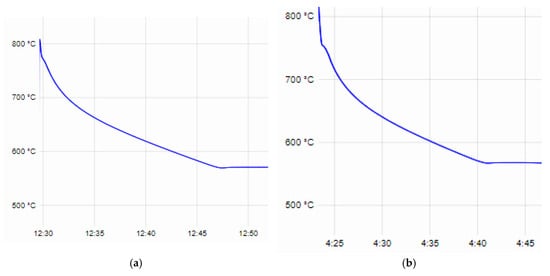
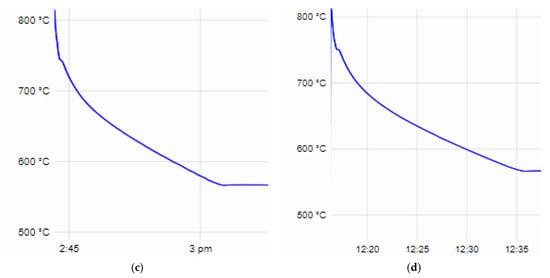
Figure 1.
Time–temperature curves recorded during thermal analysis: (a) AlSi25Cu4Cr alloy; (b) AlSi25Cu4CrNiMo alloy (No. 1); (c) AlSi25Cu4CrNiCoMo alloy (No. 2); (d) AlSi25Cu4CrNiCoMo alloy (No. 3).
The beginning of the crystallization process of the base alloy AlSi25Cu5Cr begins at a temperature of TL—779 °C and ends at a temperature of TS—567.6 °C. The supercooling of the alloy at the eutectic temperature is ∆T—1.3 °C (Figure 2a). Alloying the alloy with different concentrations of Co and Mo leads to a decrease in both the temperature of the liquidus line and the solidus line of the alloys, and no significant difference in the degree of supercooling of the alloys ∆T was recorded. The parameters of the crystallization process of alloy No. 4 are TL—759.3 °C, TS—566.7 °C and ∆T—1.3 °C (Figure 2b); for alloy No. 5, they are TL—758.8 °C, TS—566.5 °C and ∆T—1.1 °C (Figure 2c). The results of the microstructural analysis conducted show no differences in the structure of the base and those alloyed with Co and Mo, and, after T6 heat treatment, the eutectic silicon in the structure of the alloys has a spheroidal shape and small dimensions [,].
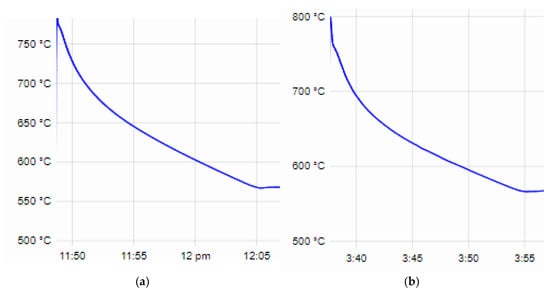
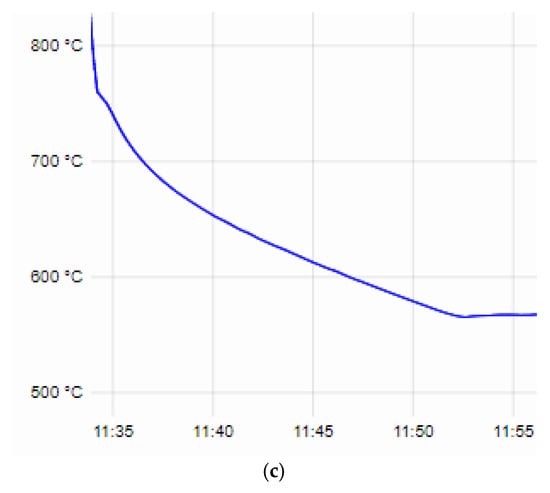
Figure 2.
Time–temperature curves recorded during thermal analysis: (a) AlSi25Cu5Cr alloy; (b) AlSi25Cu4CrCoMo alloy (No. 4); (c) AlSi25Cu4CrNiCoMo alloy (No. 5).
The values of the liquidus and solidus line temperatures, as well as the degrees of supercooling of the alloys at the eutectic crystallization temperature obtained from the thermal analysis, are presented in Table 4.

Table 4.
Thermal analysis results.
To study the influence of alloying elements on the structural composition of the alloys, a phase analysis was conducted. Three iron-containing phases were registered in the structure of the studied compositions. While the presence of the phases Al0.3Fe3Si0.7 and Fe4Si2 is expected, the compound Fe3PO7 in the composition of which phosphorus is involved is of interest. In alloys No. 1, No. 2 and No. 3, which are alloyed with Ni another phosphorus-containing phase, Ni8P3 was registered. The presence of intermetallics with the participation of phosphorus confirms the assumption that phosphorus works not only as a type II modifier but also as a surface-active substance (type I modifier) and participates in the composition of various chemical compounds, which, in turn, reduces its modifier effect on primary silicon crystals in the composition of hypereutectic aluminum–silicon alloys. In the composition of alloys alloyed with Ni, the Al3Ni2 phase is registered, which, according to a number of authors, is the basis of the increased heat resistance of aluminum alloys. Intermetallics with the participation of Cr and Mo are not registered, which in turn indicates that they participate in the α-solid solution. Alloying with minimal amounts of Co (alloys No. 2 and No. 3) does not lead to the formation of phases with the participation of cobalt; it, apparently, only dissolves in Al and strengthens the α-crystals. By increasing the amount of cobalt (alloys No. 4 and No. 5), a complex intermetallic with its participation (Al7CoCu2) is registered. The influence of alloying elements on the structure and mechanical properties of the studied alloys is discussed in []. The results of the phase analysis of the studied alloys are shown in Table 5, and Figure 3 shows an example comparison of samples from the study.

Table 5.
Phase analysis results.
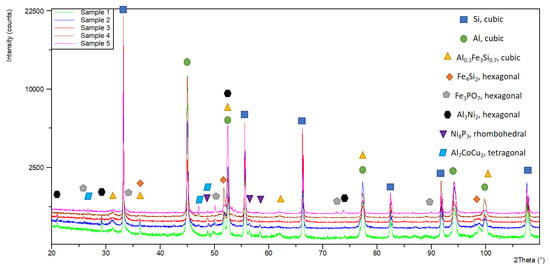
Figure 3.
Comparison of diffraction diagrams of samples.
After T6 heat treatment, a microstructural analysis of the studied alloys was carried out. In the structure of alloy No. 1 (AlSi25Cu4CrNiMo), the silicon crystals in the eutectic composition are in the form of plates with a conditional average linear size of 13.15 µm. The free silicon crystals have a relatively regular shape and a conditional average diameter of 19.6 µm. Single silicon crystals with an irregular shape are also observed (Figure 4a). In the structure of alloy No. 2 (AlSi25Cu4CrNiCoMo), the silicon crystals can be conditionally divided into two groups. The first has a conditional average diameter of 16.4 µm, and the second has dimensions of about 40.5 µm. Single silicon crystals of irregular shape are also observed. Eutectic Si is in the form of plates with dimensions reaching 26.05 µm (Figure 4b). Similarly to alloy No. 2, in alloy No. 3 (AlSi25Cu4CrNiCoMo) the primary silicon crystals are of different sizes. One group of silicon crystals are of regular shape and sizes, up to 27.7 µm, and the second group of silicon crystals are of irregular shape and have a conditional average diameter of 52.5 µm. The eutectic silicon crystals are of needle-like shape, with an average linear size of 17.2 µm (Figure 4c). In the structure of alloy No. 4 (AlSi25Cu5CrCoMo), the free silicon crystals are relatively irregular in shape. The measured and calculated conditional mean diameter is 32.2 µm. Silicon in the composition of the eutectic is spheroidal in shape and has a conditional mean diameter of 11 µm (Figure 4d). The results of the microstructural analysis of alloy No. 5 (AlSi25Cu5CrCoMo) show that, as in alloy No. 4, the free silicon crystals are irregular in shape. They are small and have a conditional average diameter of 21.27 µm. According to their shape, the eutectic silicon in the structure of this alloy can be conditionally divided into two groups. The first group contains needle-shaped crystals with average linear dimensions of 15.2 µm, and the second group includes eutectic silicon crystals with a spheroidal shape and a conditional average diameter of 5.49 µm (Figure 4e). The results obtained from the microstructural analysis of the studied alloys confirm the assumption that the participation of the modifier phosphorus in various intermetallics (Fe3PO7, Ni8P3) reduces its modifying effect on the primary silicon crystals in the composition of the hypereutectic aluminum–silicon alloys.
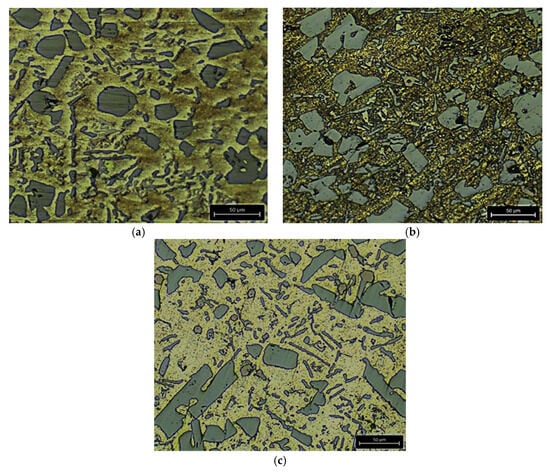
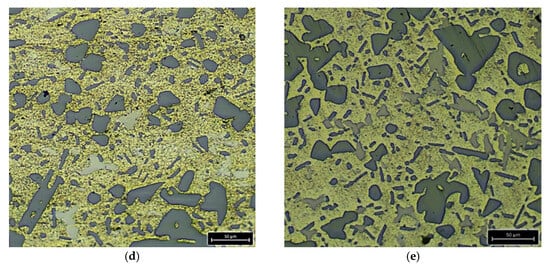
Figure 4.
Structures of the studied alloys after T6 heat treatment: (a) AlSi25Cu4CrNiMo alloy (No. 1); (b) AlSi25Cu4CrNiCoMo alloy (No. 2); (c) AlSi25Cu4CrNiCoMo alloy (No. 3); (d) AlSi25Cu5CrCoMo alloy (No. 4); (e) AlSi25Cu5CrCoMo alloy (No. 5).
To study the influence of the alloying elements Ni, Co and Mo after T6 heat treatment on the corrosion resistance of the alloys, corrosion tests of the compositions in 1 M HCl solution and 1 M H2SO4 solution for 336 h and 504 h were carried out. The gravimetric method was used, in which the mass loss of the test bodies determines their corrosion rate, and the research methodology is presented in []. The results of the calculated corrosion rate (CR g/m2·h) of the compositions in 1 M HCl are presented in Table 6, and the results obtained for the investigated characteristic (CR g/m2·h) in 1 M H2SO4 are shown in Table 7.

Table 6.
Corrosion rate (CR g/m2·h) in 1 M HCl.

Table 7.
Corrosion rate (CR g/m2·h) in 1 M H2SO4.
The use of combinations of alloying elements Ni and Mo, Ni, Co and Mo, as well as Co and Mo for alloying the AlSi25Cu4Cr and AlSi25Cu5Cr alloys, is appropriate. In the case of AlSi25Cu4Cr and AlSi25Cu5Cr, alloys alloyed with refractory metals (Ni, Co and Mo) over the course of the study, it was observed, with an increase in the concentration of the alloying elements, their corrosion resistance in 1 M H2SO4 increases. The use of the alloying elements Ni, Co and Mo has a positive effect on the corrosion resistance of the AlSi25Cu4Cr and AlSi25Cu5Cr alloys in 1 M HCl, and the same tendency is observed in them during boiling as in 1 M H2SO4. The mass loss of the test specimens in 1 M HCl solution is lower compared to 1 M H2SO4 solution, i.e., under the specified experimental conditions, the alloys have a low corrosion rate in 1 M HCl.
On the surface of aluminum and its alloys in acidic media, there are usually different areas on which anodic and cathodic reactions are localized, represented by the following equations:
Anodic Reaction: 2Al → 2Al3+ + 6e−
Cathodic Reaction: 6H+ + 6e− → 3H2
In the samples subjected to longer exposure in 1 M H2SO4, a lower corrosion rate was observed (Table 7, samples 1, 3, 4 and 5), with the probable reason for this being the formation of a protective layer on the surface of the studied alloys.
Using a Leica DM ILM metallographic microscope, the maximum penetration depth of the used corrosion media (1 M H2SO4 and 1 M HCl) in the test specimens of the studied alloys after the maximum test period (504 h) was measured. Figure 5 shows the results of the test in 1 M H2SO4, and Figure 6 shows the results of the test in 1 M HCl.
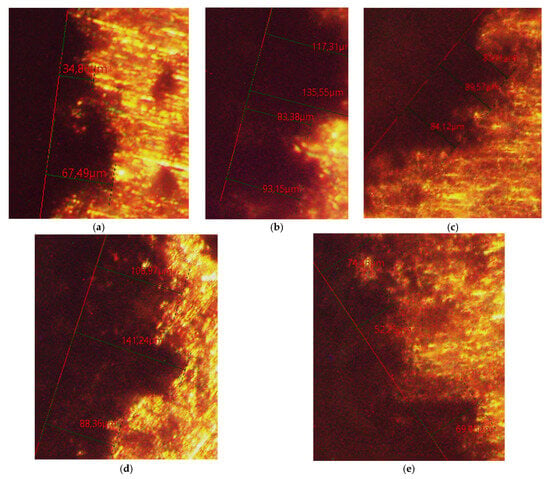
Figure 5.
Maximum measured penetration depth of the corrosive medium 1 M H2SO4 after the maximum test period of 504 h in the test specimens of the tested alloys: (a) AlSi25Cu4CrNiMo alloy (No. 1); (b) AlSi25Cu4CrNiCoMo alloy (No. 2); (c) AlSi25Cu4CrNiCoMo alloy (No. 3); (d) AlSi25Cu5CrCoMo alloy (No. 4); (e) AlSi25Cu5CrCoMo alloy (No. 5).
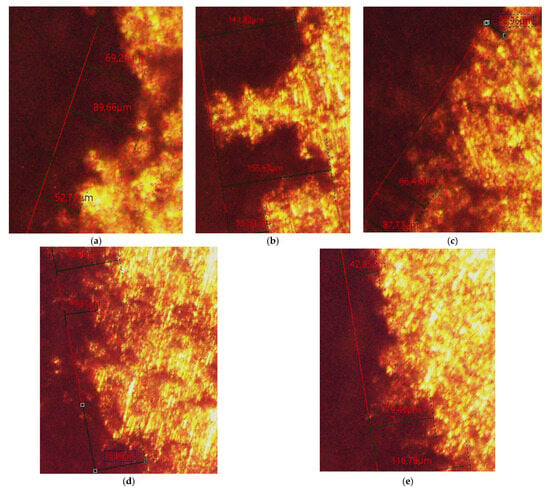
Figure 6.
Maximum measured penetration depth of the corrosive medium 1 M HCl after the maximum test period of 504 h in the test specimens of the tested alloys: (a) AlSi25Cu4CrNiMo alloy (No. 1); (b) AlSi25Cu4CrNiCoMo alloy (No. 2); (c) AlSi25Cu4CrNiCoMo alloy (No. 3); (d) AlSi25Cu5CrCoMo alloy (No. 4); (e) AlSi25Cu5CrCoMo alloy (No. 5).
4. Discussion
The conducted studies have established the influence of the combinations of alloying elements Ni, Co and Mo on the crystallization process of non-standardized hypereutectic aluminum–silicon alloys. The temperature range of the studied compositions is narrow, but nevertheless, no differences in the shape and size of the primary silicon crystals in the alloy structures are observed [,]. The narrower temperature range of crystallization is a prerequisite for the reduction in micro-suction porosity during solidification of the castings, which will inevitably lead to an increase in their quality. The temperatures at which the crystallization process begins have been registered, which is of essential importance for the technological process of melting and the casting of the alloys. Knowing the liquidus temperatures of the alloys, there is no possibility of excessive overheating of the melts or a risk of their gas saturation. It is possible to determine the optimal casting temperature of the alloys, which will avoid the state of zero thinness, i.e., to obtain castings with exact shapes and dimensions. The temperatures of eutectic crystallization of the studied compositions have been taken into account. This is of extreme importance in regard to the subsequent heat treatment of the alloys. The determination of the temperature for heating and homogenizing the structure of the alloys for quenching is directly dependent on the temperature of the solidus lines of the alloys. The correct choice of the heating temperature before quenching is a prerequisite of the maximum dissolution of the alloying elements in the α-crystals and the fixation of a maximally saturated α-solid solution after quenching. Thus, during the subsequent artificial aging, the process of formation, growth and distribution of secondary strengthening phases can be controlled, i.e., alloys with increased mechanical and improved operational properties can be obtained. The alloying elements used and their combinations are the basis for obtaining alloys with increased mechanical properties in tests conducted at normal temperatures []. During the phase analysis, it was established that the alloying elements Cr and Mo do not form strengthening phase, and it was also established that they participate in the α-solid solution. The same applies to Co when it is used in minimal quantities; when using higher concentrations of Co, its participation in the ternary intermetallic Al7CoCu2 (alloys No. 4 and No. 5) is registered. The presence of the phosphorus-containing phases Fe3PO7 and Ni8P3 confirms the assumptions that phosphorus works not only as a type II modifier but also as a surfactant (type I modifier); it also participates in the composition of various chemical compounds, which, in turn, reduces its modifying effect on primary silicon crystals in the composition of hypereutectic aluminum–silicon alloys.
The use of combinations of the alloying elements Ni, Co and Mo has a more positive effect on the structure and properties of the AlSi25Cu4Cr and AlSi25Cu5Cr alloys [] and makes them competitive with the established piston hypereutectic aluminum–silicon alloys. This, in turn, is a prerequisite for future studies of such alloyed alloys and will help in determining their mechanical properties at elevated temperatures and their wear resistance in tribological systems.
5. Conclusions
It was found that the combinations of the used alloying elements Ni, Co and Mo narrow the temperature range in regard to the crystallization of the studied alloys. The temperatures at the beginning and end of the crystallization process of the compositions were recorded, which is of utmost importance for the processes of melting and casting of the alloys, as well as for the subsequent heat treatment.
The elements Cr and Mo, as well as Co, when used in minimal amounts, do not form secondary strengthening phases but dissolve in the α-solid solution. The results of the corrosion tests conducted in 1 M HCl solution and 1 M H2SO4 solution for 336 h and 504 h show that the elements Ni, Co and Mo improve the corrosion resistance of the alloys compared to the base alloys AlSi25Cu4Cr and AlSi25Cu5Cr.
Author Contributions
All authors declare equal contribution to this manuscript. All authors have read and agreed to the published version of the manuscript.
Funding
This research was funded by the European Regional Development Fund under the Operational Program “Scientific Research, Innovation and Digitization for Smart Transformation 2021-2027”, Project CoC “Smart Mechatronics, Eco- and Energy Saving Systems and Technologies”, BG16RFPR002-1.014-0005.
Institutional Review Board Statement
Not applicable.
Informed Consent Statement
Written informed consent has been obtained from the patient(s) to publish this paper.
Data Availability Statement
The original contributions presented in this study are included in the article. Further inquiries can be directed to the corresponding authors.
Acknowledgments
The authors would like to thank the European Regional Development Fund under the Operational Program “Scientific Research, Innovation and Digitization for Smart Transformation 2021-2027”, Project CoC “Smart Mechatronics, Eco- and Energy Saving Systems and Technologies”, BG16RFPR002-1.014-0005 for the financial support. The work of CTU staff was supported by the Grant Agency of the Czech Technical University in Prague, grant No. SGS22/183/OHK4/3T/14.
Conflicts of Interest
The authors declare no conflicts of interest.
References
- Kandeva, M.; Dochev, B.; Dimova, D.; Zagorski, M.; Kasabov, P. Investigation of the wear resistance of tribological systems composed of aluminium-silicon alloys: PART 1. J. Balk. Tribol. Assoc. 2024, 30, 59–66. [Google Scholar]
- Kandeva, M.; Dochev, B.; Dimova, D.; Zagorski, M.; Kasabov, P. Investigation of the wear resistance of tribological systems composed of aluminium-silicon alloys: PART 2. J. Balk. Tribol. Assoc. 2024, 30, 208–217. [Google Scholar]
- Mahle GmbH. Piston materials. In Pistons and Engine Testing. ATZ/MTZ-Fachbuch; Vieweg+Teubner Verlag: Wiesbaden, Germany, 2012. [Google Scholar] [CrossRef]
- Miladinović, S.; Stojanović, B.; Gajević, S.; Vencl, A. Hypereutectic Aluminum Alloys and Composites: A Review. Available online: https://link.springer.com/article/10.1007/s12633-022-02216-2 (accessed on 10 November 2022).
- Joseph, O.O.; Olubambi, P.A.; Joseph, O.O.; Edun, B.M.; Okeniyi, J.O.; Abioye, O.P. Effects of Alloying on Aluminium-Silicon Alloys—A Review. IOP Conf. Ser. Mater. Sci. Eng. 2021, 1107, 012116. [Google Scholar] [CrossRef]
- Efzan, M.N.E.; Kong, H.J.; Kok, C.K. Review: Effect of Alloying Element on Al-Si Alloys. Adv. Mater. Res. 2013, 845, 355–359. [Google Scholar] [CrossRef]
- Abalymov, V.R.; Zhereb, V.P.; Kleimenov, Y.A.; Antonov, M.M. Effect of Heat Treatment on the Structure and Mechanical Properties of Eutectic Silumin Alloyed with Magnesium. Met. Sci. Heat Treat. 2021, 63, 291–296. [Google Scholar] [CrossRef]
- Elsharkawi, E.A.; Ibrahim, M.F.; Samuel, A.M.; Doty, H.W.; Samuel, F.H. Understanding the Effect of Be Addition on the Microstructure and Tensile Properties of Al–Si–Mg Cast Alloys. Int. J. Met. 2022, 16, 1777–1795. [Google Scholar] [CrossRef]
- Liu, X.; Wang, C.; Zhang, S.; Song, J.; Zhou, X.; Zha, M.; Wang, H. Fe-Bearing Phase Formation, Microstructure Evolution, and Mechanical Properties of Al-Mg-Si-Fe Alloy Fabricated by the Twin-Roll Casting Process. J. Alloys Compd. 2021, 886, 161202. [Google Scholar] [CrossRef]
- Furui, M.; Kitamura, T.; Ishikawa, T.; Ikeno, S.; Saikawa, S.; Sakai, N. Evaluation of Age Hardening Behavior Using Composite Rule and Microstructure Observation in Al-Si-Mg Alloy Castings. Mater. Trans. 2011, 52, 1163–1167. [Google Scholar] [CrossRef]
- Stanić, D.; Brodarac, Z.Z.; Li, L. Influence of Copper Addition in AlSi7MgCu Alloy on Microstructure Development and Tensile Strength Improvement. Metals 2020, 10, 1623. [Google Scholar] [CrossRef]
- Wang, E.R.; Hui, X.D.; Wang, S.S.; Zhao, Y.F.; Chen, G.L. Improved Mechanical Properties in Cast Al-Si Alloys by Combined Alloying of Fe and Cu. Mater. Sci. Eng. A 2010, 527, 7878–7884. [Google Scholar] [CrossRef]
- Jeong, C. High Temperature Mechanical Properties of AlSiMg-(Cu) Alloys for Automotive Cylinder Heads. Mater. Trans. 2013, 54, 588–594. [Google Scholar] [CrossRef]
- Bogdanoff, T.; Lattanzi, L.; Merlin, M.; Ghassemali, E.; Jarfors, A.E.W.; Seifeddine, S. The Complex Interaction between Microstructural Features and Crack Evolution during Cyclic Testing in Heat-Treated Al–Si–Mg–Cu Cast Alloys. Mater. Sci. Eng. A 2021, 825, 141930. [Google Scholar] [CrossRef]
- Lumley, R.N.; Gunasegaram, D.R.; Gershenzon, M.; O’Donnell, R.G. Effect of Alloying Elements on Heat Treatment Response of Aluminium High Pressure Die Castings. Int. Heat Treat. Surf. Eng. 2010, 4, 25–32. [Google Scholar] [CrossRef]
- Pratheesh, K.; Ravi, M.; Kanjirathinkal, A.; Joseph, M.A. Effects of Sr and Pressure on Microstructure, Mechanical and Wear Properties of near Eutectic Al–Si Piston Alloys. Int. J. Cast Met. Res. 2015, 28, 301–309. [Google Scholar] [CrossRef]
- Demirtaş, H.; Karakulak, E.; Babu, N.H. Understanding the Effect of Ni Content on Microstructure and Mechanical Properties of A384 HPDC Alloy. J. Alloys Compd. 2022, 896, 163111. [Google Scholar] [CrossRef]
- Lattanzi, L.; Giovanni, M.T.; Giovagnoli, M.; Fortini, A.; Merlin, M.; Casari, D.; Di Sabatino, M.; Cerri, E.; Garagnani, G.L. Room Temperature Mechanical Properties of A356 Alloy with Ni Additions from 0.5 Wt to 2 Wt%. Metals 2018, 8, 224. [Google Scholar] [CrossRef]
- Fedak, M.; Rimar, M.; Corny, I.; Kuna, S. Experimental Study of Correlation of Mechanical Properties of Al-Si Casts Produced by Pressure Die Casting with Si/Fe/Mn Content and Their Mutual Mass Relations. Adv. Mater. Sci. Eng. 2013, 2013, 585514. [Google Scholar] [CrossRef]
- Ozyurek, D.; Yıldırım, M.; Yavuzer, B.; Simsek, I.; Tuncay, T. The Effect of Ni Addition on Microstructure and Mechanical Properties of Cast A356 Alloy Modified with Sr. Met. Mater. 2021, 59, 391–399. [Google Scholar] [CrossRef]
- Mbuya, T.O.; Odera, B.O.; Ng’ang’a, S.P. Influence of Iron on Castability and Properties of Aluminium Silicon Alloys: Literature Review. Int. J. Cast Met. Res. 2003, 16, 451–465. [Google Scholar] [CrossRef]
- Totten, G.E.; Tiryakioglu, M.; Kessler, O. (Eds.) Encyclopedia of Aluminum and Its Alloys; CRC Press: Boca Raton, FL, USA, 2019. [Google Scholar] [CrossRef]
- Szymczak, T.; Gumienny, G.; Klimek, L.; Goły, M.; Szymszal, J.; Pacyniak, T. Characteristics of Al-Si Alloys with High Melting Point Elements for High Pressure Die Casting. Materials 2020, 13, 4861. [Google Scholar] [CrossRef]
- Zhang, L.; Gao, J.; Damoah, L.; Robertson, D.G. Removal of Iron from Aluminum: A Review. Miner. Process. Extr. Metall. Rev. 2012, 33, 99–157. [Google Scholar] [CrossRef]
- Hwang, J.Y.; Doty, H.W.; Kaufman, M.J. The Effects of Mn Additions on the Microstructure and Mechanical Properties of Al-Si-Cu Casting Alloys. Mater. Sci. Eng. A 2008, 488, 496–504. [Google Scholar] [CrossRef]
- Taylor, J.A. Iron-Containing Intermetallic Phases in Al-Si Based Casting Alloys. Procedia Mater. Sci. 2012, 1, 19–33. [Google Scholar] [CrossRef]
- Švecová, I.; Tillová, E.; Kuchariková, L.; Knap, V. Possibilities of Predicting Undesirable Iron Intermetallic Phases in Secondary Al-Alloys. Transp. Res. Procedia 2021, 55, 797–804. [Google Scholar] [CrossRef]
- Dunn, R. Aluminum Melting Problems and Their Influence on Furnace Selection. Die Cast. Eng. B 1965, 9, 8–30. [Google Scholar]
- Kumar, L.; Cheol, J.; Hui, J.; Kwang, S.S. Effects of Cr and Ti Addition on Mechanical Properties and Thermal Conductivity of Al–7Si–3Mg Die-casting Alloys. Met. Mater. Int. 2022, 29, 204–214. [Google Scholar] [CrossRef]
- Ling, H.; Shi, H.; Du, X.; Zan, J.; Liu, J. Effect of Chromium Content on Microstructure and Properties of Casting Al-7Si-0.35Mg-0.02Sr Alloy. Mater. Werkst. 2022, 53, 1229–1241. [Google Scholar] [CrossRef]
- Liang, Y.; Cui, C.; Geng, H.; Liu, L.; Zhang, S.; Jin, R. Synergistic Effects of Cr and Sr Addition on the Mechanical and Corrosion Properties of A356.2 Alloy. Mater. Charact. 2022, 191, 112152. [Google Scholar] [CrossRef]
- Li, Y.; Yang, Y.; Wu, Y.; Wei, Z.; Liu, X. Supportive Strengthening Role of Cr-Rich Phase on Al-Si Multicomponent Piston Alloy at Elevated Temperature. Mater. Sci. Eng. A 2011, 528, 4427–4430. [Google Scholar] [CrossRef]
- Wang, X.; Ma, P.; Meng, Z.; Zhang, S.; Liu, X.; Wang, C.; Wang, H. Effect of Trace Cr Alloying on Centerline Segregations in Sub-Rapid Solidified Al–Mg–Si (AA6061) Alloys Fabricated by Twin-Roll Casting. Mater. Sci. Eng. A 2021, 825, 141896. [Google Scholar] [CrossRef]
- Kaufman, J.G.; Rooy, E.L. Aluminum Alloy Castings: Properties, Processes, and Applications, 1st ed.; ASM International: Amiel, The Netherlands, 2004. [Google Scholar]
- Lumley, R.N. Fundamentals of Aluminium Metallurgy: Production, Processing and Applications; Woodhead Publishing: Suston, UK, 2011. [Google Scholar]
- Polmear, I.; StJohn, D.; Nie, J.-F.; Qian, M. Light Alloys: Metallurgy of the Light Metals, 5th ed.; Elsevier: Amsterdam, The Netherlands, 2017. [Google Scholar]
- Ganesh, M.R.S.; Reghunath, N.; Levin, M.J.; Prasad, A.; Doondi, S.; Shankar, K.V. Strontium in Al–Si–Mg Alloy: A Review. Met. Mater. Int. 2022, 28, 1–40. [Google Scholar] [CrossRef]
- Nafisi, S.; Ghomashchi, R. Effects of Modification during Conventional and Semi-Solid Metal Processing of A356 Al-Si Alloy. Mater. Sci. Eng. A 2006, 415, 273–285. [Google Scholar] [CrossRef]
- Vincze, F.; Tokár, M.; Fegyverneki, G.; Gyarmati, G. Examination of the Eutectic Modifying Effect of Sr on an Al-Si-Mg-Cu Alloy Using Various Technological Parameters. Arch. Foundry Eng. 2020, 2020, 79–84. [Google Scholar] [CrossRef]
- Sigworth, G.K. The Modification of Al-Si Casting Alloys: Important Practical and Theoretical Aspects. Int. J. Met. 2008, 2, 19–40. [Google Scholar] [CrossRef]
- Flores, A.V.; Lopez, J.C.; Escobedo, J.C.B.; Castillejos, A.H.E.; Acosta, F.A.G. Effects of S and Sb Additions on the Microstructure and Mechanical Properties of the Al-Si 319 Alloy. Can. Metall. Q. 1994, 33, 133–138. [Google Scholar] [CrossRef]
- Medlen, D.; Bolibruchova, D. Effect of Sb-Modification on the Microstructure and Mechanical Properties of Secondary Alloy 319. Arch. Metall. Mater. 2016, 61, 553–558. [Google Scholar] [CrossRef][Green Version]
- Zuo, M.; Zhao, D.; Teng, X.; Geng, H.; Zhang, Z. Effect of P and Sr complex modification on Si phase in hypereutectic Al–30Si alloys. Mater. Des. 2013, 47, 857–864. [Google Scholar] [CrossRef]
- Njuguna, B.; Li, J.; Tan, Y.; Sun, Q.; Li, P. Grain refinement of primary silicon in hypereutectic Al-Si alloys by different P-containing compounds. China Foundry 2021, 18, 37–44. [Google Scholar] [CrossRef]
- Guan, R.; Tie, D. A review on grain refinement of aluminum alloys: Progresses, challenges and prospects. Acta Metall. Sin. 2017, 30, 409–432. [Google Scholar] [CrossRef]
- Shi, W.; Gao, B.; Tu, G.; Li, S. Effect of Nd on microstructure and wear resistance of hypereutectic Al–20%Si alloy. J. Alloys Compd. 2010, 508, 480–485. [Google Scholar] [CrossRef]
- Panov, I.; Dochev, B.; Manolov, V.; Velikov, A.; Diyakova, V.; Kuzmanov, P. Investigation of the potential of simultaneous modification of hypereutectic aluminum-silicon AlSi18 alloy with conventional and nano-modifier. IFAC-PapersOnLine 2019, 52, 488–493. [Google Scholar] [CrossRef]
- Radev, D.; Tomova, Z.; Vlahova, A.; Marinov, M.; Kovacheva, D. Comparative study on some structural properties of Ni- and Co base dental alloys produced by thermal alloying and powder metallurgical methods. Mater. Today 2022, 61, 1265–1271. [Google Scholar] [CrossRef]
- Tomova, Z.; Chonin, A.; Stoeva, I.; Vlahova, A. Clinical and laboratory study of corrosion resistance of a base dental alloy for selective laser melting. Folia Med. 2023, 65, 664–670. [Google Scholar] [CrossRef] [PubMed]
- Tomova, Z.; Vlahova, A.; Zlatev, S.; Stoeva, I.; Tomov, D.; Davcheva, D.; Hadzhigaev, V. Clinical Evaluation of Corrosion Resistance, Ion Release, and Biocompatibility of CoCr Alloy for Metal-Ceramic Restorations Produced by CAD/CAM Technologies. Dent. J. 2023, 11, 166. [Google Scholar] [CrossRef]
- Kamarska, K.; Dimova, D.; Dochev, B.; Dubaradjieva, M.; Peeva, N.; Demirev, T. Investigation of the Corrosion Resistance of Complex Alloyed Hypereutectic Aluminium-Silicon Alloys. In Proceedings of the 15th International Scientific Conference on Aeronautics, Automotive, and Railway Engineering and Technologies (BulTrans-2023), Sozopol, Bulgaria, 22 February 2024; Volume 3129. [Google Scholar] [CrossRef]
- Dochev, B. Thermal analysis of aluminum-silicon alloys AlSi25Cu4Cr and AlSi25Cu5Cr modified with different phosphorus concentrations. In Proceedings of the National Youth Forum “SCIENCE, TECHNOLOGY, INNOVATIONS, BUSINESS”, Plovdiv, Bulgaria, 5–6 May 2022; pp. 116–122. (In Bulgarian). [Google Scholar]
- Dochev, B.; Dimova, D.; Panov, I.; Boichev, Y. Investigation of the Structure and Mechanical Properties of Alloys AlSi25Cu4Cr and AlSi25Cu5Cr Alloyed with Refractory Metals. In Proceedings of the 15th International Scientific Conference on Aeronautics, Automotive, and Railway Engineering and Technologies (BulTrans-2023), Sozopol, Bulgaria, 22 February 2024; Volume 3129. [Google Scholar] [CrossRef]
Disclaimer/Publisher’s Note: The statements, opinions and data contained in all publications are solely those of the individual author(s) and contributor(s) and not of MDPI and/or the editor(s). MDPI and/or the editor(s) disclaim responsibility for any injury to people or property resulting from any ideas, methods, instructions or products referred to in the content. |
© 2025 by the authors. Licensee MDPI, Basel, Switzerland. This article is an open access article distributed under the terms and conditions of the Creative Commons Attribution (CC BY) license (https://creativecommons.org/licenses/by/4.0/).